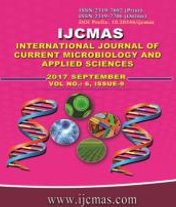


 National Academy of Agricultural Sciences (NAAS)
National Academy of Agricultural Sciences (NAAS)

|
PRINT ISSN : 2319-7692
Online ISSN : 2319-7706 Issues : 12 per year Publisher : Excellent Publishers Email : editorijcmas@gmail.com / submit@ijcmas.com Editor-in-chief: Dr.M.Prakash Index Copernicus ICV 2018: 95.39 NAAS RATING 2020: 5.38 |
Soil microflora and their diversity study are now modern trends to know the proper soil health. Greater diversity of fungi in soil indicates better health of soil. In this experiment agricultural soil, barren land and garden soil were taken for their micromycoflora study and the diversity of microfungi were analysed by Simpson index and compared among the three types of soil. Total 563 colonies were isolated from the 38 soil samples collected from three different ecosystem types. Sixty eight (68) different species belonging to 31 genera were recorded. Maximum variation was observed in the agriculture soil, 350 colonies were isolated from 20 samples having 67 species and 31 genera. In all 54 species belonging to 28 genera were isolated from barren land samples. In the Garden soil samples, there were 123 colonies belonging to 30 genera and 66 species. Three genera (Candida, Debaryomyces and Rhodotorula) of yeasts were isolated and identified in three types of soil of this municipality and adjoining area. The study reveals that T. viride exists in maximum per cent of occurrence. It is a good indication of that as T. viride is natural biocontrol agent against many plant pathogens. Aspergillus was dominant in all the three types of soils followed by, Trichoderma, Fusarium, Alternaria, Penicillium and Gloeosporium. Aspergillus has 9 species, Penicillium has 6 species, Curvularia has 5 species. The diversity Simpson index (0.6139) is found in agriculture soil in comparison to barren (0.9763) and garden (0.950) soil. It means maximum diversity of fungi exists in the agriculture soil. Fungi get maximum and varied nutrient from agriculture soil. So agriculture soil supports maximum diversity of fungi.
 |
 |
 |
 |
 |